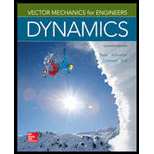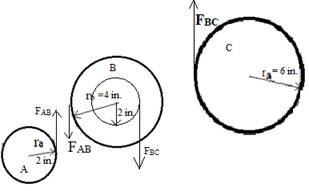
Concept explainers
Gear A weighs 1 lb and has a radius of gyration of 1.3 in.; gear B weighs 6 lb and has a radius of gyration of 3 in.; gear C weighs 9 lb and has a radius of gyration of 4.3 in. Knowing a couple M of constant magnitude of 40 lb
i.
The angular acceleration of gear C.
Answer to Problem 16.37P
Angular acceleration of gear C = 129.99 rad/s2
Explanation of Solution
Given:
weight of Gear A, wa = 1 lb radius of gyration of gear A,
radius of gear A = 2 in.
weight of gear B, wb = 6 lb
radius of gyration of gear B,
radius of gear B, r1 = 4 in.; r2 = 2 in.
weight of Gear C, wc = 9 lb
radius of gyration of gear C,
radius of gear C = 6 in.
Magnitude of Couple applied on gear A, M = 40lb-in. = 40/12 lb-ft = 3.333 lb-ft
Concept used:
Mass moment of acceleration is given by-
The tangential force acting on a gear will provide the angular acceleration to the gear. Therefore,
The free body diagram of the three gears is as following-

Calculation:
Mass of gear A =
Mass of gear B =
Mass of gear C =
Mass moment of inertia of gear A =
Mass moment of inertia of gear B =
Mass moment of inertia of gear A =
At the point of contact between A and B
At the point of contact between B and C
For gear A,
For gear B,
For gear C,
Conclusion:
Angular acceleration of gear C = 129.99 rad/s2
ii.
The tangential force that gear B exerts on gear C.
Answer to Problem 16.37P
Force exerted by gear B on gear C = 9.33 lb
Explanation of Solution
Given:
weight of Gear A, wa = 1 lb radius of gyration of gear A,
radius of gear A = 2 in.
weight of gear B, wb = 6 lb
radius of gyration of gear B,
radius of gear B, r1 = 4 in.; r2 = 2 in.
weight of Gear C, wc = 9 lb
radius of gyration of gear C,
radius of gear C = 6 in.
Magnitude of Couple applied on gear A, M = 40lb-in. = 40/12 lb-ft = 3.333 lb-ft
Angular acceleration of gear C = 129.99 rad/s2
Concept used:
Mass moment of acceleration is given by-
The tangential force acting on a gear will provide the angular acceleration to the gear. Therefore,
The free body diagram of the three gears is as following-

Calculation:
Mass of gear A =
Mass of gear B =
Mass of gear C =
Mass moment of inertia of gear A =
Mass moment of inertia of gear B =
Mass moment of inertia of gear A =
At the point of contact between A and B
At the point of contact between B and C
For gear A,
For gear B,
As found in part I,
Angular acceleration of gear C = 129.99 rad/s2
Tangential force of gear B, on gear C-
Conclusion:
Angular acceleration of gear C = 129.99 rad/s2
Force exerted by gear B on gear C = 9.33 lb
Want to see more full solutions like this?
Chapter 16 Solutions
Vector Mechanics for Engineers: Dynamics
- Two uniform cylinders, each of weight W = 14 lb and radius r = 5 in., are connected by a belt as shown. Knowing that at the instant shown the angular velocity of cylinder B is 30 rad/s clockwise, determine (a) the distance through which cylinder A will rise before the angular velocity of cylinder B is reduced to 5 rad/s, (b ) the tension in the portion of belt connecting the two cylinders.arrow_forwardTwo uniform cylinders, each of mass m = 6 kg and radius r = 125 mm, are connected by a belt as shown. Knowing that at the instant shown the angular velocity of cylinder A is 30 rad/s counterclockwise, determine (a) the time required for the angular velocity of cylinder A to be reduced to 5 rad/s, (b) the tension in the portion of belt connecting the two cylinders.arrow_forwardQ2. Two uniform disks of the same material are attached to a shaft as shown. Disk A has a weight of 10 lb and a radius r = 6 in. Disk B is twice as thick as disk A. Knowing that a couple M of magnitude 22 lb. ft is applied to disk A when the system is at rest, determine the radius nr of disk B if the angular velocity of the system is to be 480 rpm after 5 revolutions. A M b B 2barrow_forward
- D C Answer: B 0.4 m- 0.4 m Two identical slender rods AB and BC are welded together to form an L-shaped assembly. The assembly is pressed against a spring at D and released from the position shown. Knowing that the maximum angle of rotation of the assembly in its subsequent motion is 58° with the horizontal (counterclockwise), determine the magnitude of the angular velocity of the assembly as it passes through the position where rod AB forms an angle of 27° with the horizontal.arrow_forwardThe gear train shown consists of four gears of the same thickness and of the same material; two gears are of radius r, and the other two are of radius nr. The system is at rest when the couple M0 is applied to shaft C. Denoting by I0 the moment of inertia of a gear of radius r, determine the angular velocity of shaft A if the couple M0 is applied for one revolution of shaft C.arrow_forwardThe blade of a portable saw and the rotor of its motor have a total weight of 2.5 lb and a combined radius of gyration of 1.5 in. Knowing that the blade rotates as shown at the rate w1= 1500 rpm, determine the magnitude and direction of the couple M that a worker must exert on the handle of the saw to rotate it with a constant angular velocity w2= -(2.4 rad/s)j.arrow_forward
- In the helicopter shown; a vertical tail propeller is used to pre- vent rotation of the cab as the speed of the main blades is changed. Assuming that the tail propeller is not operating determine the final angular velocity of the cab after the speed of the main blades has been changed from I80 to 240 rpm. (The speed of the main blades is measured relative to the cab, and the cab has a centroidal moment of inertia of 650 lb.ft.s2. Each of the four main blades is assumed to be a slender rod 14 ft weighing 55 lb.)arrow_forwardEach of the gears A and B has a mass of 675 g and a radius of gyration of 40 mm, while gear C has a mass of 3.6 kg and a radius of gyration of 100 mm. Assume that kinetic friction in the bearings of gears A, B C produces couples of constant magnitude 0.15 N.m, 0.15 N.m, 0.3 N.m, respectively. Knowing that the initial angular velocity of gear C is 2000 rpm, determine the time required for the system to come to rest.arrow_forwardDisk A, of weight 10 lb and radius r = 6 in., is at rest when it is placed in contact with belt BC, which moves to the right with a constant speed v = 40 ft/s. Knowing that μk = 0.20 between the disk and the belt, determine the number of revolutions executed by the disk before it attains a constant angular velocity.arrow_forward
- Problem (1) Gears A and B each have a mass of 4 kg and a radius of gyration of 75 mm about their centers, while gear C has a mass of 15 kg and a radius of gyration of 180 mm about its center. A couple moment M = (0.20) N-m is applied to gear C. Determine the number of revolutions gears A and B experience if gear C increases its angular velocity from 25 rpm to 500 rpm. B 80 mm S0 mm 200 mmarrow_forwardGear A has a mass of 1 kg and a radius of gyration of 30 mm; gear B has a mass of 4 kg and a radius of gyration of 75 mm; gear C has a mass of 9 kg and a radius of gyration of 100 mm. The system is at rest when a couple M0 of constant magnitude 4 N.m is applied to gear C . Assuming that no slipping occurs between the gears, determine the number of revolutions required for disk A to reach an angular velocity of 300 rpm.arrow_forwardTwo uniform cylinders, each of weight W=14 lb and radius r = 5 in, are connected by a belt as shown. Knowing that at the instant shown the angular velocity of cylinder A is 30 rad/sec counterclockwise, determine (a) the time required for the angular velocity of cylinder A to be reduced to 5 rad/sec, (b) the tension in the portion of belt between the two cylinders. *** Solve using the method of impulse-momentum *** Barrow_forward
 Elements Of ElectromagneticsMechanical EngineeringISBN:9780190698614Author:Sadiku, Matthew N. O.Publisher:Oxford University Press
Elements Of ElectromagneticsMechanical EngineeringISBN:9780190698614Author:Sadiku, Matthew N. O.Publisher:Oxford University Press Mechanics of Materials (10th Edition)Mechanical EngineeringISBN:9780134319650Author:Russell C. HibbelerPublisher:PEARSON
Mechanics of Materials (10th Edition)Mechanical EngineeringISBN:9780134319650Author:Russell C. HibbelerPublisher:PEARSON Thermodynamics: An Engineering ApproachMechanical EngineeringISBN:9781259822674Author:Yunus A. Cengel Dr., Michael A. BolesPublisher:McGraw-Hill Education
Thermodynamics: An Engineering ApproachMechanical EngineeringISBN:9781259822674Author:Yunus A. Cengel Dr., Michael A. BolesPublisher:McGraw-Hill Education Control Systems EngineeringMechanical EngineeringISBN:9781118170519Author:Norman S. NisePublisher:WILEY
Control Systems EngineeringMechanical EngineeringISBN:9781118170519Author:Norman S. NisePublisher:WILEY Mechanics of Materials (MindTap Course List)Mechanical EngineeringISBN:9781337093347Author:Barry J. Goodno, James M. GerePublisher:Cengage Learning
Mechanics of Materials (MindTap Course List)Mechanical EngineeringISBN:9781337093347Author:Barry J. Goodno, James M. GerePublisher:Cengage Learning Engineering Mechanics: StaticsMechanical EngineeringISBN:9781118807330Author:James L. Meriam, L. G. Kraige, J. N. BoltonPublisher:WILEY
Engineering Mechanics: StaticsMechanical EngineeringISBN:9781118807330Author:James L. Meriam, L. G. Kraige, J. N. BoltonPublisher:WILEY





